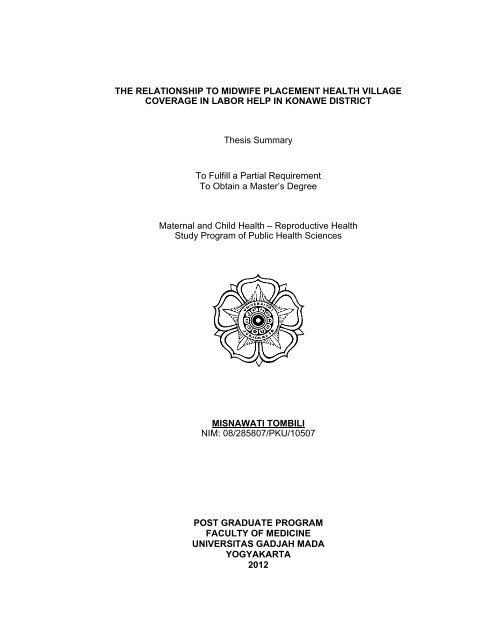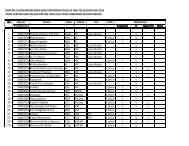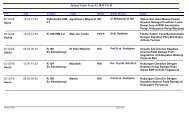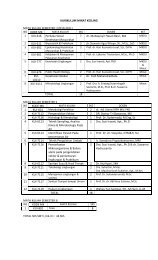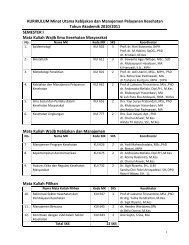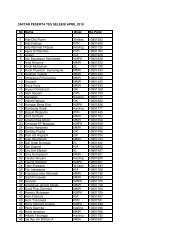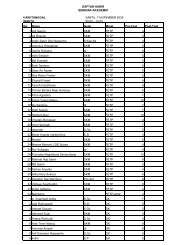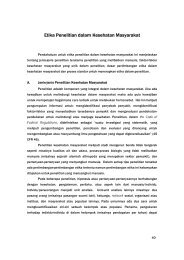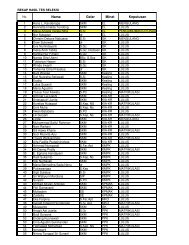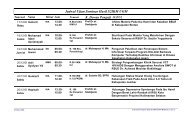THE RELATIONSHIP TO MIDWIFE PLACEMENT HEALTH VILLAGE ...
THE RELATIONSHIP TO MIDWIFE PLACEMENT HEALTH VILLAGE ...
THE RELATIONSHIP TO MIDWIFE PLACEMENT HEALTH VILLAGE ...
Create successful ePaper yourself
Turn your PDF publications into a flip-book with our unique Google optimized e-Paper software.
<strong>THE</strong> <strong>RELATIONSHIP</strong> <strong>TO</strong> <strong>MIDWIFE</strong> <strong>PLACEMENT</strong> <strong>HEALTH</strong> <strong>VILLAGE</strong><br />
COVERAGE IN LABOR HELP IN KONAWE DISTRICT<br />
L<br />
Thesis Summary<br />
To Fulfill a Partial Requirement<br />
To Obtain a Master’s Degree<br />
Maternal and Child Health – Reproductive Health<br />
Study Program of Public Health Sciences<br />
MISNAWATI <strong>TO</strong>MBILI<br />
NIM: 08/285807/PKU/10507<br />
POST GRADUATE PROGRAM<br />
FACULTY OF MEDICINE<br />
UNIVERSITAS GADJAH MADA<br />
YOGYAKARTA<br />
2012
<strong>THE</strong> RELLATIONSHIP<br />
<strong>TO</strong> MIDWWIFE<br />
PLAC CEMENT H<strong>HEALTH</strong><br />
VIILLAGE<br />
COVERAGEE<br />
IN LABORR<br />
HELP IN KONAWEE<br />
DISTRICT T<br />
AAdvisor<br />
I<br />
ddr.<br />
Ova Emmilia,<br />
SpOGG(K),<br />
M.M.EEd,<br />
Ph.D.<br />
AAdvisor<br />
II<br />
ddr.<br />
Lutfan Lazuardi, M.Kes, Ph.D.<br />
APPRROVAL<br />
SHEET<br />
Prroposed<br />
byy:<br />
MISNAAWATI<br />
<strong>TO</strong>MMBILI<br />
NIM: 08/2285807/PKU<br />
U/10507<br />
Appproved<br />
byy:<br />
Dated, …… ……….<br />
Dated, …… ……….
<strong>THE</strong> <strong>RELATIONSHIP</strong> OF <strong>THE</strong> <strong>PLACEMENT</strong> OF <strong>VILLAGE</strong> MIDWIVES<br />
<strong>TO</strong> <strong>THE</strong> COVERAGE OF DELIVERY ASSISTANCE BY SKILLED BIRTH<br />
ATTENDANTS IN KONAWE DISTRICT<br />
CHAPTER I<br />
BACKGROUND<br />
Maternal Mortality Rate (MMR) in Indonesia is 228 per 100,000 live<br />
births and in Southeast Sulawesi Province is 279 per 100,000 live births<br />
(CBS and Macro International, 2007). Based on data in 2009, the number<br />
of maternal and infant mortality in Konawe District was 5 and 34 cases,<br />
respectively, from 2449 deliveries (Konawe District Health Office, 2009).<br />
This was related to the inequity of the midwife placements.<br />
In Konawe, the number of midwives is 155 people spreading over<br />
364 villages. This situation shows that the ratio of midwives to the working<br />
area is 1:2. This means that almost 57.5% of villages in Konawe do not<br />
have a village midwife (Konawe District Health Office, 2009).<br />
Based on the background, the formulated problem in this study was<br />
"whether there is any relation of the village midwife placement to the<br />
coverage of delivery assistance by health personnel in Konawe District?"<br />
The aim of this study was to determine the relationship of the placement of<br />
village midwives to the coverage of delivery assisted by skilled birth<br />
attendant in Konawe.<br />
CHAPTER II<br />
LITERATURE REVIEW<br />
The high maternal and perinatal mortality rates indicate poor<br />
service to the community during pregnancy and childbirth. One dominant<br />
factor is antenatal care in which there are lack of quality service in labor<br />
and delivery and lack of regulation about obstetric procedures<br />
(Manandhar, 2004). This situation is related to the skills of birth attendant<br />
during childbirth process and to the women themselves (Harvey et al.,<br />
2007).<br />
1
The placement of village midwives could reduce maternal and<br />
neonatal mortality. The high maternal and neonatal mortality in Indonesia<br />
can be attributed that most women living in the rural areas have deliveries<br />
at home assisted by a traditional birth attendant, so that delivery<br />
complications are not addressed comprehensively (Shrestha, 2010). The<br />
provision of primary health care in rural communities and the utilization of<br />
services by the community are the indicators of the health program<br />
success. Ease access to health services makes the birth-related risk<br />
factors can be easily overcome (Kruk et al., 2009). Services done by<br />
midwives can improve referral for delivery with complications and reduce<br />
maternal and infant mortality (Lassi et al., 2010).<br />
CHAPTER III<br />
METHODS<br />
This was an observational study with a cross-sectional study<br />
design, i.e. research that makes the measurement of independent and<br />
dependent variables simultaneously. The research was conducted in the<br />
working area of Konawe Health Office, while the unit of analysis of this<br />
study was the village that received village midwife services.<br />
The population of this study was the village midwives who provided<br />
services to rural communities in the working area of Konawe Health Office<br />
District by a decree of the head of Health Office. The inclusion criteria<br />
were midwives living in the working area of Konawe Health Office and the<br />
village midwives assisting villages under the decree of the head of Health<br />
Office. The exclusion criterion was the village midwives who were<br />
undergoing their further education. The qualitative samples were the head<br />
of Health Office, the head of the Regional Human Resources Agency<br />
(BKD), the head of the Indonesian Midwives Association (IBI) of Konawe<br />
District and village midwives.<br />
The number of samples in this study was the entire study<br />
population comprising 155 midwives serving in the working area of<br />
2
Konawe Health Office. For qualitative data, the number of samples<br />
consisted of three heads of institutions, namely Health Office, BKD, IBI<br />
and a midwife.<br />
The variables of this study were the independent variable which<br />
was the placement of village midwife, the dependent variables which were<br />
indicator of the delivery coverage and complications of childbirth and the<br />
extraneous variables which were the residence, length of work, and<br />
delivery service facilities. The instruments used were a questionnaire and<br />
a check list of research and in-depth interviews to the research subjects in<br />
accordance with the in-depth interview guidelines.<br />
Data processing used the following steps: editing, coding, entry,<br />
and cleaning. After that, the data analysis was carried out including:<br />
univariable, bivariable, and multivariable. The statistic test used chi-square<br />
and logistic regression with confidence interval (CI) 95% and the level of<br />
significance with p value
low coverage of delivery assistance by midwives like in Lambuya sub<br />
District which only had 2 midwives.<br />
The results showed that there was a significant relationship<br />
between midwives’ residence and the coverage of delivery by skilled birth<br />
attendant with p =
The results of this study found a significant relationship between<br />
facility and the coverage of delivery by skilled birth attendant with p =<br />
the rules, regulations, budgets, system improvements, facilities and<br />
infrastructure. The support of the government increased the performance<br />
of midwives in childbirth assistance. This situation was related to the<br />
situation in Konawe in which there were no regulations in in the<br />
implementation of delivery assistance and there were no local regulations.<br />
There was no significant relationship between facility and complications of<br />
childbirth. The occurrence of complications in this study was more likely to<br />
be caused by other factors such as midwife’s skill.<br />
Based on multivariable analysis on the variable of the service<br />
coverage by health personnel, the more dominant variable in predicting<br />
the coverage of delivery by health personnel was facilities with OR = 5.47.<br />
The availability of health care facilities greatly affected the scope of<br />
delivery. Rural communities tended to utilize services within easy reach.<br />
This situation was appropriate to the circumstances in which some areas<br />
in Konawe are islands so the location of the access to service utilization<br />
tends to be chosen closest to the population.<br />
Based on complications of childbirth, the more dominant variable<br />
affecting the non occurrence of complications of labor was length of<br />
service. This situation suggests that the experience and skills in delivery<br />
assistance is the important state in preventing the complications of<br />
childbirth.<br />
Midwives who had long worked and resided in the village led to the<br />
ease of interaction with the community so pregnancy and childbirth could<br />
be known by the village midwife. Information about pregnancy and<br />
childbirth by midwives had an impact on the detection of complications<br />
that could be readily handled. Handling of the complications could be<br />
through a labor referral mechanism. The success deliveries by midwives<br />
needed strong political support from local governments. Political support<br />
could increase capacity and strengthen the system with a focus on<br />
delivery quality by increasing the number of midwives.<br />
6
CHAPTER V<br />
CONCLUSIONS AND RECOMMENDATIONS<br />
From the above results, it can be concluded that the distribution of<br />
the placement of village midwives are largely in urban region. The<br />
coverage of delivery by health workers is higher in villages with midwives<br />
compared with the villages without village midwives. The more dominant<br />
factor that impacts on the coverage of labor is a factor of health care<br />
facilities. The factor of length of service is not dominant to the occurrence<br />
of complications in childbirth. Delivery bleeding is the complication that<br />
often occurs in births attended by midwives in Konawe.<br />
Suggestions that can be submitted are as follows: 1) the need for<br />
the addition of village midwives in Konawe especially for village which<br />
have not received midwives, 2) the provision of service facilities to the<br />
village such as village clinics, and 3) the need to increase the ability of<br />
midwives in assisting labors through training and seminars on delivery<br />
bleeding management.<br />
REFFERENCE<br />
Aggarwal, A. K., Kumar, R. & Kumar, P. (2003) Early neonatal mortality in a hilly<br />
north Indian state: Socio-demographic factors and treatment seeking<br />
behaviour. Indian Journal of Preventive and Social Medicine, 34(1-2): 46-<br />
52.<br />
Ali, M., Ayaz, M., Rizwan, H., Hashim, S. & Kuroiwa, C. (2006) Emergency<br />
obstetric care availability, accessibility and utilization in eight districts in<br />
Pakistan's North West Frontier Province. J Ayub Med Coll Abbottabad,<br />
18(4): 10-5.<br />
BPS & Macro International (2007) Survei Demografi dan Kesehatan Indonesia,<br />
Calverton, Maryland, USA:Macro International.<br />
D'Ambruoso, L., Achadi, E., Adisasmita, A., Izati, Y., Makowiecka, K. & Hussein,<br />
J. (2009) Assessing quality of care provided by Indonesian village<br />
midwives with a confidential enquiry. Midwifery, 25(5): 528-39.<br />
Dinkes Kabupaten Konawe (2009) Profil Kesehatan Kabupaten Konawe Tahun<br />
2008, Konawe:Dinkes Kabupaten Konawe.<br />
Harvey, S., Blandón, Y., McCaw-Binns, A., Sandino, I., Urbina, L., Rodríguez, C.,<br />
Gómez, I., Ayabaca, P., Djibrina, S. & Nicaraguan Maternal and Neonatal<br />
Health Quality Improvement Group (2007) Are skilled birth attendants<br />
really skilled? A measurement method, some disturbing results and a<br />
potential way forward. Bulletin of the World Health Organization, 85(10):<br />
783-790.<br />
7
Kruk, M. E., Mbaruku, G., McCord, C. W., Moran, M., Rockers, P. C. & Galea, S.<br />
(2009) Bypassing primary care facilities for childbirth: a population-based<br />
study in rural Tanzania. Health Policy Plan, 24(4): 279-88.<br />
Lassi, Z. S., Haider, B. A. & Bhutta, Z. A. (2010) Community-based intervention<br />
packages for reducing maternal and neonatal morbidity and mortality and<br />
improving neonatal outcomes. Cochrane Database Syst Rev,<br />
11CD007754.<br />
Manandhar, D. (2004) Perinatal death audit. Kathmandu University Medical<br />
Journal 2(8): 375-383.<br />
Palutturi, S., Nurhayani & Mandak, N. (2007) Determinan kinerja bidan di<br />
puskesmas tahun 2006. Jurnal Manajemen Pelayanan Kesehatan, 10(4):<br />
195 - 200.<br />
Ray, A. M. & Salihu, H. (2004) The impact of maternal mortality interventions<br />
using traditional birth attendants and village midwives. Journal of<br />
Obstetrics & Gynaecology, 24(1): 5-11.<br />
Shrestha, R. (2010) The village midwife program and infant mortality in Indonesia<br />
Bulletin of Indonesian Economic Studies, 46(2): 193-211.<br />
Smith, J., Coleman, N., Fortney, J., Johnson, J., Blumhagen, D. & Grey, T.<br />
(2000) The impact of traditional birth attendant training on delivery<br />
complications in Ghana. Health Policy and Planning, 15(3): 326-331.<br />
Styles M, Cheyne H, O'Carroll R, Greig F, Dagge-Bell F & C., N. (2010) The<br />
scottish trial of refer or keep (the S<strong>TO</strong>RK study): midwives' intrapartum<br />
decision making. Midwifery.<br />
8


